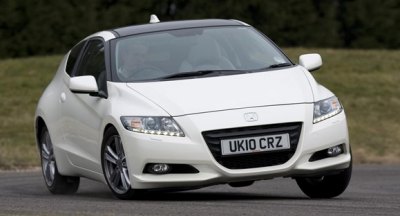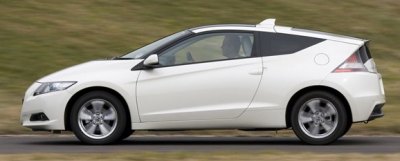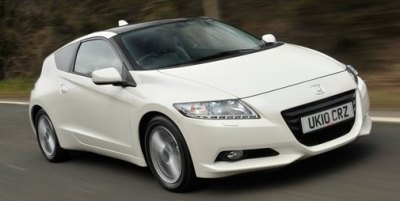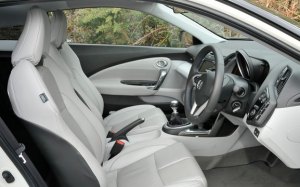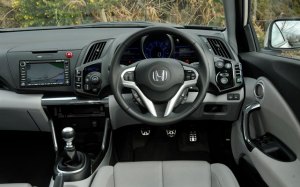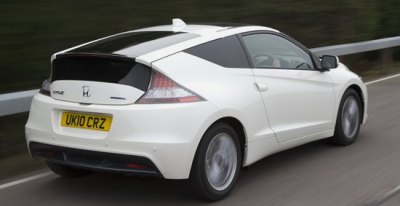Honda CR-Z
Debut: 2010 |
|||||||||||
Following the demise of S2000 and the withdrawal from Formula One racing, Honda seems to have completely abandoned its sporting route. Now all engineering resources are concentrated on green technologies in the attempt to catch Toyota as the leader in this field. The first fruit is Insight, probably the first ever affordable hybrid car. Unfortunately, judging from last year's sales figures it is not exactly a huge success. Blame must go to the IMA hybrid system, which is less costly but also less efficient than Toyota's Hybrid Synergy Drive. Apparently, Honda's hybrid offerings are not good enough to compete head on with Toyota's equivalents. They can succeed only if a) Toyota runs out of capacity, or b) Honda does something different. How about building a hybrid sports car ? That would be an interesting idea. Not necessarily sensible, but at least worth exploring. Making a hybrid sports car is not as difficult as imagined. You can take the Insight as basis, lower it, widen its tracks, chop 115 mm from its wheelbase and turn it into a 2+2 coupe. Tune its suspensions and steering sportier. Give it all-wheel disc brakes. Replace the Insight's 1.3-liter 8-valve engine and continuous variable transmission with a more powerful 1.5-liter 16-valve i-VTEC engine and a 6-speed manual gearbox. Finally, enclose all these things with a sporty design inspired by the late CRX and name the car CR-Z. Now you get the world's first hybrid sports car as well as a chance to fill the missing link between the old, sporty Honda and the new, green Honda.
For a coupe this small and this cheap (about same price as Mazda MX-5), the CR-Z looks quite stunning. Its lines are sharp and aggressive. Its steeply sloping bonnet is unique in the era hit by pedestrian safety law, thanks to the compact design of its cylinder head. The two-piece glass tailgate gives the strongest visual link to the second generation CRX – and unfortunately both result in poor visibility. My only complaint is the small wheels. In 16-inch they appear too small in relation to the body side. Some pronounced wheel arches like those of the original Ford Focus or Audi TT may improve the visual effect a lot. Anyway, in current form the CR-Z is still a head-turning little coupe. Open the bonnet, you will see the compact IMA power system. It is so small because its DC brushless electric motor, sitting beside the engine, is good for only 13.6 horsepower. The small Nickel-metal hydride (NiMH) battery pack and the associated power control unit are stored under the boot floor. The 1.5 SOHC i-VTEC motor is not exactly tuned for power, otherwise Honda would have chosen its more powerful DOHC unit. It actually comes from Fit (Jazz), so it is a compromise between power and fuel economy. At low rpm its i-VTEC mechanism closes one intake valve per cylinder to create swirl, improving air-fuel mixing hence torque and fuel economy. Its maximum output is 114hp and 107 lb-ft, compare favourably with Insight's 88hp and 91 lb-ft. Working together with the electric motor, combined maximum output is 124hp and 128 lb-ft. That is enough to pull the 1150 kg coupe from rest to 60 mph in 9 seconds and flat out Autobahn at 200km/h.
Now you may point out the CRX of 23 years ago did 0-60 mph sprint in 8 seconds flat. How could its spiritual successor be slower ? Turn elsewhere, the same-price Mazda MX-5 takes 7 seconds to do zero-to-sixty. Back to the backyard of Honda, the outgoing S2000 took just 5.6 seconds to do the same sprint. If CR-Z really "produces 2-liter class power", then the benchmarking engine must not be the one serving S2000. Admittedly, CR-Z is not exactly a pocket rocket, unlike CRX. Nevertheless, in real world driving it still feels brisk enough. Praise must go to the "supercharging effect" of electric motor, which doubles torque output below 1500 rpm, and the push is readily available as soon as you open the throttle wide. That gives the CR-Z a satisfying stream of power for accelerating out of corners or traffic lights. At higher speed, the significance of electric power fades out. The engine becomes the sole power source for high-speed cruising. The power delivery of IMA is generally seamless. Gearchange is slick and short, as you expect on a Honda coupe. On the downside, the petrol motor sounds too sporty at high rev. The rest of the car also lacks refinement by nowadays standards. In order to save weight, the chassis of CR-Z does not employ a lot of sound insulation and vibration-absorbing materials, so its cabin is troubled by a great deal of wind and road noise at speed. Even for a sporty car that is barely acceptable. In this aspect, German cars like Audi TT or Volkswagen Scirocco are much more satisfying.
The cockpit of CR-Z also lacks the style and quality of its German rivals. As in Insight, you get a busy dashboard design, some ordinary plastics and fake alloys. While durability is not in doubt, it does not feel very expensive. Fortunately, the fancy instrument display injects a sense of sophistication. The LCD color changes from blue to green if you drive economically, or glows to red when you switch to Sport mode, which weighs up the steering and increases motor output to aid a spirited drive. The cabin offers reasonable space for two. The rear seat space is very tight, thus is best leave to luggage. The chassis setup of CR-Z is quite sporty. It combines a firm ride with tight body control. It grips well, it corners with little roll and it brakes with good feel. The chassis feels well balanced and agile. The electrical power steering is quick (with 2.45 turns from lock to lock), accurate and well weighted. All these merits make the CR-Z pretty fun to drive. However, it is not one of the greatest driving machines around, because its steering lacks true feel and its chassis does not respond to throttle steer. Moreover, its remarkable body control comes at the expense of low speed ride. Its ride quality is an improvement from Insight, but bumpy B-roads may still catch it out, resulting in a bouncy ride.
In pure performance and handling terms, the CR-Z is not as good as Civic Type R or just any other good hot hatches. Those buying it are likely to be attracted by its unique style, technology and green image. It returns 56.4 mpg over European combined cycle and emits just 117 grams of carbon-dioxide per kilometer. Nothing else comes close to that, including diesel-powered rivals. Taking into account its reasonable price, CR-Z seems to enjoy a unique position in the market. It might not be as groundbreaking as CRX or S2000, but it is still worth recommending. |
|||||||||||
| The above report was last updated on 22 Apr 2010. All Rights Reserved. |
| Specifications | ||||||||||||||||||||||||||||||||||||||||||||||||||||||||||||||||||||||||||||||||||||||||
|
||||||||||||||||||||||||||||||||||||||||||||||||||||||||||||||||||||||||||||||||||||||||
| Performance tested by: *Autocar, **C&D |
Copyright©
1997-2010
by Mark Wan @ AutoZine
